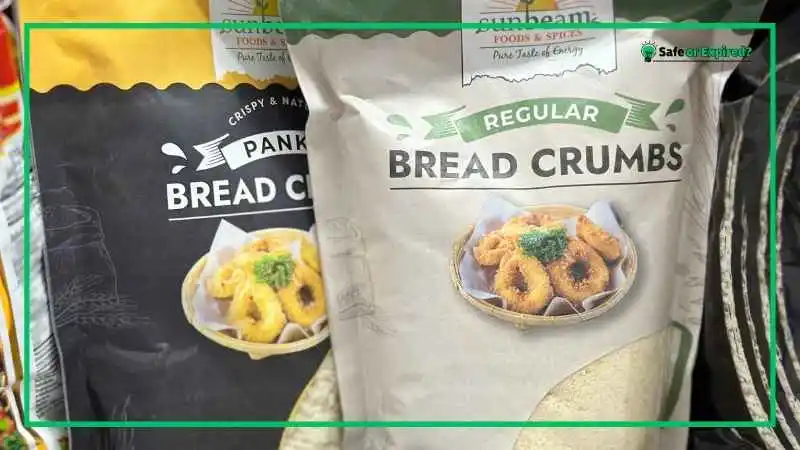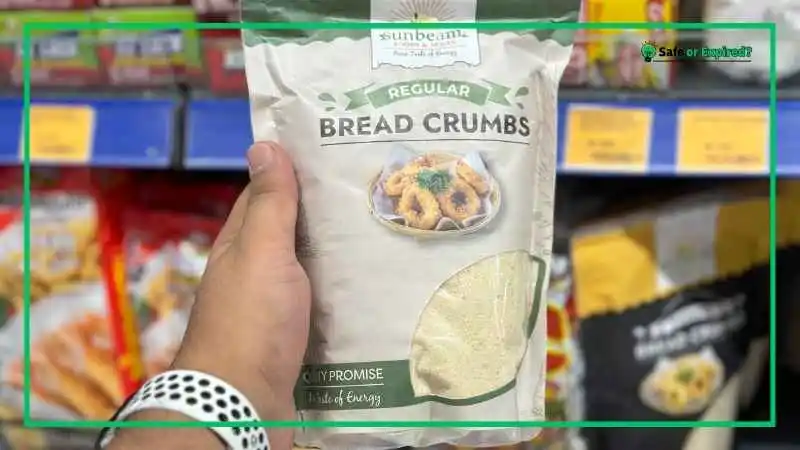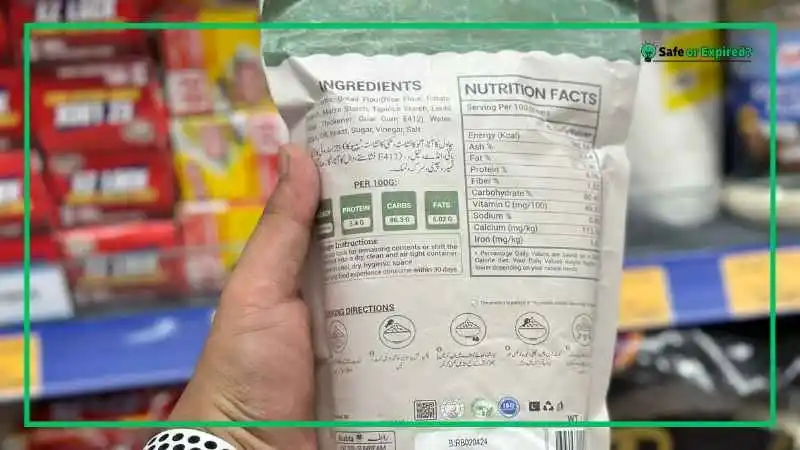“Do bread crumbs go bad?” is a common question among home cooks. Yes, bread crumbs can spoil over time, developing mold or strange smells. Knowing how to spot bad bread crumbs can save your meals and keep you healthy. Stick around to learn all the details that will help you avoid any frustration in the future.
Do Bread Crumbs Go Bad? All You Need to Know
Yes, bread crumbs do go bad. Just like any other food product, they have a shelf life and can become stale, moldy, or lose their texture and flavor over time. Bread crumbs can last varying lengths of time depending on how they are stored.
If kept unopened, they generally last longer than when opened. Here’s a breakdown:
Shelf Life of Unopened Bread Crumbs
- Pantry: Unopened bread crumbs can last up to a year when stored in a cool, dry place.
- Fridge: In the fridge, they can last even longer, up to 18 months.
- Freezer: Freezing unopened bread crumbs can extend their life to about two years.
Shelf Life of Opened Bread Crumbs
- Pantry: Once opened, bread crumbs should be used within six months.
- Fridge: Do you refrigerate bread crumbs after opening? Yes. They can last about nine months if you do.
- Freezer: How long do bread crumbs last after opening if frozen? Up to a year, provided they are stored in an airtight container.
Here’s a handy table to visualize the shelf life of bread crumbs:
| Storage Method | Counter | Fridge | Freezer |
| Opened | One year | One year | Two years |
| Unopened | Nine months | 18 months | 2 years |
Remember that it’s a general table. I suggest checking the expiration or best by date printed on the package and then eating the bread crumbs within this period.

Do Progresso Bread Crumbs Go Bad?
Yes, Progresso bread crumbs do go bad. Like other bread crumbs, Progresso’s shelf life depends on how they are stored. If kept unopened in a cool, dry pantry, they can last up to a year. Once opened, it’s essential to store them in an airtight container.
In the pantry, opened Progresso bread crumbs can last about six months. If you store them in the fridge, they can last up to nine months, and in the freezer, they can last up to a year.
Do Seasoned Bread Crumbs Go Bad?
Seasoned bread crumbs also go bad, and their shelf life is similar to plain bread crumbs. The added spices and herbs can slightly alter their shelf life, but generally, unopened seasoned bread crumbs last up to a year when stored in a cool, dry pantry.
If stored in the fridge, they can last up to nine months, and in the freezer, they can be kept for about a year.
Do Canned Bread Crumbs Go Bad?
Yes, canned bread crumbs can go bad, though they often have a longer shelf life due to the canning process. Unopened canned bread crumbs can last up to two years when stored in a dry pantry, thanks to the airtight seal that prevents contamination and moisture.
Can Panko Crumbs Go Bad? Everything to Know

Yes, panko crumbs can go bad, although they tend to have a longer shelf life than regular bread crumbs due to their drier texture. Unopened panko crumbs can last up to 18 months when stored in a dry place. Once opened, it’s important to keep them in an airtight container.
So, how do you tell panko bread crumbs have gone bad? To tell if panko bread crumbs have gone bad, check for an off smell, mold, or changes in texture and color. If they smell rancid, appear discolored, or have a strange taste, discard them. Additionally, if they’ve been stored for too long past their expiration date, it’s best to replace them.
Do Dried Breadcrumbs Go Bad?
Yes, dried breadcrumbs do go bad, although their shelf life is typically longer than fresh bread crumbs. Unopened dried breadcrumbs can last up to a year when stored in a dry place. Once opened, they should be kept in an airtight container to prevent moisture from getting in.
Do Sealed Bread Crumbs Go Bad?

Yes, sealed bread crumbs can go bad, but they generally have a longer shelf life due to the airtight packaging. Unopened sealed bread crumbs can last up to a year when stored in a cool, dry place. The seal helps protect the crumbs from moisture and contamination, significantly extending their shelf life.
Once the seal is broken, the bread crumbs should be transferred to an airtight container. Opened bread crumbs stored properly in the pantry can last up to 6 months. If refrigerated, they can stay fresh for up to 9 months, and if frozen, they can last up to a year.
Can Italian Bread Crumbs Go Bad? Crucial Details
Yes, Italian bread crumbs can go bad. Unopened, they typically have a shelf life of up to a year when stored in a cool, dry place. The added herbs and spices in Italian bread crumbs can sometimes shorten their shelf life slightly compared to plain bread crumbs.
Are Breadcrumbs Good After Expiration Date?
Breadcrumbs can still be good after their expiration date, but several considerations must be taken into account. The expiration date usually indicates when the product is expected to retain its best quality, but properly stored breadcrumbs may remain safe to use beyond this date.
If breadcrumbs have been stored in a dry place in an airtight container, they might still be good. Storing breadcrumbs in the fridge or freezer can extend their shelf life significantly, with frozen breadcrumbs lasting up to a year past their expiration date.
So, whenever someone asks, “Can I use expired bread crumbs?” we tell them to consider it. Always inspect breadcrumbs before using them. Look for signs of mold, discoloration, or an off smell.
If any of these are present, it’s best to discard them. Breadcrumbs may also lose their crispness and flavor over time, which can affect the quality of your recipes even if they are safe to eat. Plus, you won’t be able to enjoy the nutritional benefits (printed on the package).

Can Expired Bread Crumbs Make You Sick? Yes or No?
Yes, consuming expired bread crumbs can make you sick. If bread crumbs have gone bad, they might harbor mold or bacteria, leading to food poisoning symptoms like stomach pain, nausea, vomiting, and diarrhea. Always check for any off smells or mold before using them to ensure they are safe to eat.
Stomach Pain
Eating Italian bread crumbs past the expiration date can cause stomach pain. When bread crumbs go bad, they might develop mold or bacteria. These can upset your stomach and cause discomfort. You might feel cramps or a burning sensation.
If you notice any pain after eating expired bread crumbs, it’s best to rest and drink plenty of water. Avoid eating anything else until you feel better. If the pain gets worse or lasts a long time, it’s important to see a doctor. They can check if there’s a more serious problem.
Always check your bread crumbs before using them to avoid this issue.
Nausea and Vomiting
Another side effect of eating expired bread crumbs is nausea and vomiting. Mold and bacteria in old bread crumbs can upset your digestive system. This can make you feel queasy and may lead to vomiting. If you feel nauseous after eating expired bread crumbs, try to stay calm and rest.
Drinking small sips of water can help. Vomiting can make you feel weak, so it’s important to take care of yourself. If you can’t stop vomiting or start feeling very sick, you should see a doctor.
It’s always a good idea to inspect your bread crumbs for any signs of spoilage to prevent nausea and vomiting.
Diarrhea
Eating expired bread crumbs can also cause diarrhea. This happens because mold or bacteria in the crumbs can irritate your intestines.
If you get diarrhea after eating expired bread crumbs, drink plenty of fluids to stay hydrated. Avoid eating heavy or spicy foods until you feel better. Diarrhea usually goes away on its own, but if it lasts for more than a couple of days or if you feel very sick, it’s important to see a doctor.
Allergic Reactions
Sometimes, eating expired bread crumbs can cause allergic reactions. Mold can trigger allergies in some people. You might experience symptoms like sneezing, a runny nose, or itchy eyes. In more serious cases, you could have trouble breathing.
If you notice any allergic reactions after eating expired bread crumbs, stop eating them right away and see a doctor if your symptoms are severe. Keeping your bread crumbs in a cool, dry place and using them before they expire can help avoid these problems.
And while we’re on the topic of food preservation, make sure you don’t fall for common misconceptions. Check out these 10 misleading food preservation myths to avoid making mistakes in your kitchen.
Food Poisoning
The most serious risk of eating expired bread crumbs is food poisoning. Mold and bacteria in old crumbs can cause severe illness. Symptoms of food poisoning include severe stomach pain, vomiting, diarrhea, fever, and chills.
If you suspect food poisoning, it’s important to stay hydrated and seek medical attention immediately. Food poisoning can be very serious and requires proper care.
To avoid food poisoning, always check your bread crumbs for signs of spoilage and store them correctly. Using them before they expire is the best way to keep yourself safe.
How To Tell if Bread Crumbs Are Bad? 5 Key Signs
To tell if bread crumbs are bad, check for mold, unusual smells, and changes in color or texture. If they smell off, look discolored, or feel clumpy, it’s time to throw them out. Also, if they taste stale or weird, don’t use them.
Mold
If you see any fuzzy spots or patches that are green, blue, or white, your bread crumbs have mold. Mold can grow easily in bread crumbs because they absorb moisture from the air.
I always check for mold before using bread crumbs. If I see any, I throw them away right away. Using moldy bread crumbs can make you sick, so it’s important to be careful. Always store bread crumbs in a cool, dry place to keep mold away.
Unusual Smells
Another sign that bread crumbs have gone bad is an unusual smell. Fresh bread crumbs should smell neutral or slightly like bread. If they smell sour, musty, or just off, it’s a clear sign they’re no longer good.
I always sniff the bread crumbs before using them. If they smell weird, I don’t take any chances and just toss them. Using bread crumbs that smell bad can ruin your dish and might even make you sick.
Changes in Color
Bread crumbs should look like, well, bread crumbs. If you notice any changes in color, like dark spots or yellowish patches, it means they might be bad. Fresh bread crumbs usually have a consistent color throughout.
I always check the color before using them. If they look different from when I first bought them, I don’t use them. Changes in color can mean there’s mold or other contaminants. Keeping bread crumbs in a dark, cool place helps them stay the right color.
Changes in Texture
Bread crumbs should be dry and crumbly. If they feel clumpy, sticky, or too soft, it’s a sign they’ve gone bad. Moisture can make bread crumbs spoil faster.
I always feel the bread crumbs before using them. If they don’t feel right, I throw them away. Changes in texture can mean they’ve absorbed moisture or started to spoil. Storing them in a sealed container can keep them dry and crumbly.
Taste
Finally, taste is a big indicator. Bread crumbs should taste neutral or slightly like bread. If they taste stale, sour, or just off, it means they’ve gone bad.
I usually taste a tiny bit before adding them to my dish. If they don’t taste right, I don’t use them. Eating bad-tasting bread crumbs can ruin your meal and might make you sick.
Conclusion
Understanding the shelf life of bread crumbs helps you use them at their best. Here’s a recap:
- Unopened bread crumbs last up to a year in the pantry.
- Opened bread crumbs stay fresh for about six months in the pantry.
- Storing bread crumbs in the fridge extends their life to nine months.
- Freezing bread crumbs can keep them good for up to a year.
By storing your bread crumbs properly, you can enjoy their fresh, crispy texture whenever you need them. Keep these tips in mind to make the most out of your bread crumbs!

